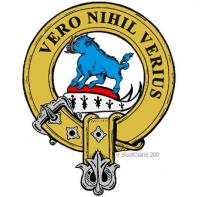
Clan Weir
The name Weir derives from the Norman 'Vere' and the name is now commonly found in Lanarkshire and other parts of Scotland.
The first person of this name mentioned in Scottish history is a Radulphus de Vere in the 12th century. He was a son of Aubrey, 1st Earl of Oxford who joined the Flemish side over succession in England. He went to Scotland in 1165, giving his allegiance to William the Lion and at the Battle of Alnwick in 1174, Ralph was captured alongside the king.
His descendants lived at Blackwood in Lanarkshire, his grandson being Richardus de Vere, who was proprietor of the lands and the Barony of Blackwood in 1296. In the same year Richardus pledged allegiance to Edward I, signing the Ragman Roll. Also that year the sherriff of Edinburgh restored forfeited land to a Thomas de Wer.
In 1400 the estate of Blackwood was confirmed by a charter to Rothald Weir and the Weirs held many lands at Kelso, where the abbey had been gifted land by Radulphus at the end of the 12th century.
The name is mentioned in 1489 when George Were took part in setting fire to the town of Dumbarton.
In 1532, Alan Lockhart received the death sentence for the murder of David and Ralph Weir, but the sentence was never carried out.
The most famous, or rather infamous Weir was Major Thomas Weir who was Captain of the Edinburgh town guard. Later he became a fervent protestant preacher, with well-attended prayer meetings. It was at one of these meetings that he suddenly confessed to witchcraft and incest. He had the dubious honour of being the last man to be burned for witchcraft in Scotland.
'Weir of Hermiston' was the title of Robert Louis Stevenson's last (unfinished) book and tells the story of Adam Weir, Lord of Hermiston, who sentences his son Archie to death.
James Weir founded the engineering company G. & J. Weir & Co in Cathcart in the 19th century.
The clan of Weir is an Armigerous clan and is recognised as a sept of the Buchanans, the MacNaughtons and the MacFarlanes.
At Blackwood, a branch of the Weirs/De Veres lived at Stonebyres Estate and records show their residence lasted from the 15th century until 1845. The house was demolished in 1934.








